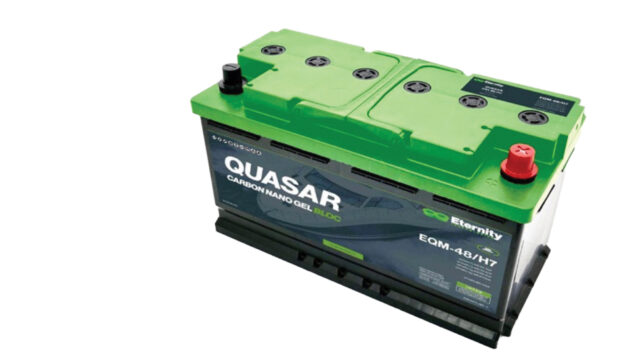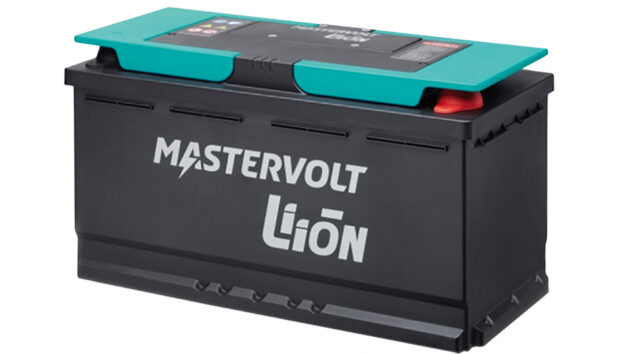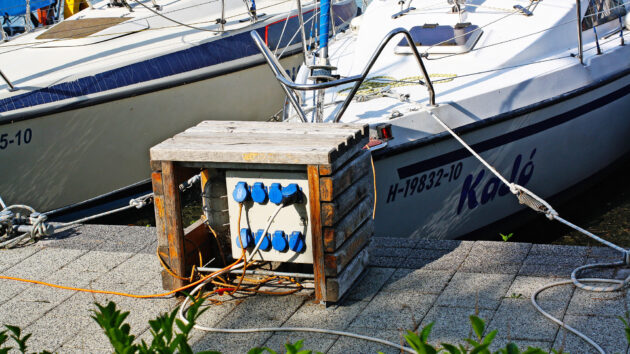Stuart James of Predator Batteries talks battery technology with Ali Wood about why lithium marine batteries may soon have had their day.
A lot of people are wondering whether to switch to lithium marine batteries, but don’t actually know what they should be looking for when buying batteries to power their life on board.
Most chandleries stock a basic range of batteries, and when a customer walks through the door and says, “I need a couple of those,” the staff don’t necessarily have the technical expertise to check that’s what they really need.
I might get a canal boat owner saying, “I’ve four batteries and I want six because they’ll last longer”. They live on board, can’t plug into shore power, and run the engine just three hours a day to charge. They’ll be lucky if the batteries last two years… So while we sell the cheap flooded batteries, we don’t try to promote them because it’s too much hassle.

Stuart James from Predator Batteries has been in the battery business since 1979. Photo: Ali Wood.
What would you recommend to the canal boat owner who wants to live off-grid?
Carbon nano gel. The same applies to yachts that are going cruising. Think of a yacht sailing to the Caribbean. You’re using the engine or the generator to charge the batteries; the batteries are working really hard, so you’ve got to put the best ones on, or they won’t last.
Do you need to make big changes to accommodate lithium marine batteries?
No. Some companies might have a separate battery management system, but similarly, a drop-in replacement would do the job. You do need to be careful, though, when charging lithium marine batteries from the engine; don’t have the engine in tickover because the alternator will work flat-out and could get too hot. You have to run the engine at a reasonable speed – at least 1,000rpm, so it’s better to use the generator.
Some people get around this by using a DC to DC charger, which only puts a maximum charge into the battery so it won’t over-work the alternator. A lot of people put these on motor homes, so they can park up for a week, turn the key and let the engine tickover for an hour, without overheating; the alternator throws out a 100A, but it’s only going to put 50A in the battery.
What’s better, gel or AGM?
The consideration with a gel battery is you can’t put as many plates in the battery as you can with an AGM, because the battery has a thick gel electrolyte, but the benefit of this is that a gel battery is far less likely to dry out.

Gel carbon batteries will charge 25% faser than AGM.
What kills an AGM battery is that the more you charge and discharge, it starts to dry out, so you can get a very high capacity with an AGM initially, but after, say, three years, that may have dropped to 80%. In a gel battery, meanwhile, it might have dropped to 95%.
The lower you discharge an AGM, the more heat you create to recharge it, and this is what dries it out. The glassfibre between the plates is very thin, and 75% of it is absorbed with acid, like a sponge. Meanwhile, a gel battery retains a nice body moisture.
What are your thoughts on lithium marine batteries?
The battery market has become quite spread. As with the lead-acid market, there’s a big range in quality.
A benefit of lithium is that it’ll run absolutely fine when half-charged. We sell Sure Start lithium marine batteries for engine-starting on small boats and RIBs. At the end of the day, you can take it home – it’s light as a feather – and charge it back up.

If a lead-acid battery falls to 50% charge over winter, it could be sulphated by the time you return to your boat. In fact, I have a fear that’ll happen this week when I return to my RIB with its 20hp Mercury on the back. I’ve got a traditional 85Ah leisure battery.
It weighs 20kg. If this is the case, I’ll replace it with a 2kg lithium battery which will do the same job, is a third of the size and 10% of the weight. They’re much more space-efficient.
However, Lithium doesn’t like very cold climates. There have been lots of problems with people trying to charge electric cars below 0°, and they don’t accept it because there’s a temperature cut-out. The way they’re getting over this now is by putting heating elements on the battery, and it needs to warm up before it can be charged.
People are considering lithium marine batteries because supposedly they last longer, and they see them in electric cars, but actually we see more sales in the caravan and RV market.
In the marine market, everybody’s heard the safety concerns. If a lithium battery catches fire, it will basically burn the boat down, and there have been some major super-yacht fires caused by lithium batteries – not the boat’s batteries, but from the sports toys they carry.
Insurance companies are sceptical about putting lithium batteries on expensive boats, and so a lot of people won’t recommend them.
How do you know your lithium marine batteries are safe?
Be very cautious about who you’re buying from. I’m the chairman of the Electric Boat Association and sell batteries for electric boats, too. I source mine from one major factory that I’ve known for 35 years. They’re experts. They buy grade A cells, which are all certified, they make their own BMS (battery management software) and each battery has to be tested and certified to meet the CE European mark.
An issue currently is you can buy less expensive lithium batteries from online retailers. Assembling lithium batteries isn’t particularly difficult and in China, there are thousands of factories that produce them. You think you can buy three and link them together, but in three or four years’ time they’ll stop working, as the cells go out of balance.
What batteries do you have on your boat?
On my 50ft Sealine, I’ve got 6 x 200Ah AGM batteries, which I fitted two years ago. If I’d had the carbon nano gel then, I’d have put those on, but there’s nothing wrong with the ones I’ve got, so there’s no point changing them yet.

Stuart recommends gel carbon batteries for canal boat users wishing to moor without a hook-up.
I either plug into shore power or start the generator if I need to top up the batteries. My 10kW generator charges the batteries at a rate of 50A which charges the engine starting batteries, the domestic batteries and the bow thruster. A couple of hours cruising will charge that all as well.
How has battery technology changed in your career?
The standard lead-acid leisure battery has been around for 40-50 years, and I was an instigator in that market, importing them from South Africa where they were very inexpensive.
At the turn of the millennium, AGM batteries came out, followed by gel batteries, but this technology had problems; people were cycling too low and not charging fully, which caused sulphation, so they added the carbon ingredient to help reduce this.
The latest improvement in design, the carbon nano tube, or ‘carbon gel’, essentially contains the carbon in a tube rather than dust. It’s an improvement on the well-known gel battery technology. Carbon gel is the nearest thing to lithium in terms of durability and how it works.
What are the benefits of carbon nano gel batteries?
A carbon nano gel battery will charge more quickly because resistance is lower, and if you don’t fully charge it, that’s not as damaging as it would be for a normal lead-acid battery.
Charter boats have all sorts of problems with standard batteries because they often don’t plug into shore power, and are never getting a full charge. You can flatten carbon gel quite low; more than AGM and standard gel. Exactly how low a voltage is a difficult question to answer, though, because you have to have everything switched off to measure the voltage.
It’s the same issue with lithium – you see the voltage go up and down and all of a sudden if you draw too much current, it will just switch off and you’ve got a problem until it resets itself. A good-quality lithium battery will do this itself in two or three minutes, but a bad one almost needs a ‘jump start’.
Are batteries recyclable?
Every battery except lithium is fully recyclable – at this time there is absolutely nowhere to dispose of a lithium battery. It’s all very well having lovely electric cars, but what do we do when we trash them? You can’t crush them because they’ll explode; there have been instances of recycling plants going up in flames because of lithium batteries.
I know this market well, and in two to three years, lithium will be replaced with sodium-ion batteries because that’s a new technology that’s far safer than lithium.
Discover Stuart’s range of batteries at predator-batteries.co.uk.
Lithium iron phosphate batteries: myths BUSTED!
Duncan Kent looks into the latest developments, regulations and myths that have arisen since lithium-ion batteries were introduced
Winterizing boat batteries: A foolproof way
Engineering guru Vyv Cox confesses to a less-than impressive track record of winterizing boat batteries – but shares his new-found
Boat power management: How to keep your batteries topped up
Now we’d decided on batteries for Maximus the next conundrum was how to keep those batteries charged. Premier Marinas had…
Lithium boat batteries: 12 of the best options tested
Boat owners have long relied upon the lead-acid battery to start their engines, run electric lights and, these days, to…
Why I chose serial electric hybrid propulsion with lead carbon batteries for my narrow boat
During the first lockdown in March 2020, my wife, Kay, and I began musing about the possibility of trying to…
Want to read more practical articles like this?

A subscription to Practical Boat Owner magazine costs around 40% less than the cover price.
Print and digital editions are available through Magazines Direct – where you can also find the latest deals.
PBO is packed with information to help you get the most from boat ownership – whether sail or power.
-
-
-
- Take your DIY skills to the next level with trusted advice on boat maintenance and repairs
- Impartial, in-depth gear reviews
- Practical cruising tips for making the most of your time afloat
-
-
Follow us on Facebook, Instagram, TikTok and Twitter









